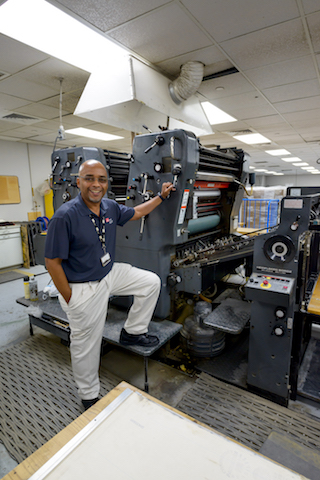
Otis Johnson stands next to a large printing press that arrived at UTMB just before he did—nearly 30 years ago. It’s a daily reminder of how far printing and graphic design has come since he started his career as a press operator.
“This is the Heidelberg offset printing press,” says Johnson, pointing to the massive machine that can only print two colors at a time. “I was in charge of running this back in the 1980s. We still use it occasionally, but the evolution of printing has been phenomenal. I’ve seen printing go from a lot of hands-on, manual work to mostly digital. People don’t want black and white copies anymore—they want colorful, glossy pieces of art.”
Over the years, the print shop has adapted and Johnson has advanced, working his way up to printing and graphics manager. He currently oversees a team of eight full-time employees who provide comprehensive graphic design and custom printing for UTMB faculty, staff and students. In a typical month, between 300 and 500 jobs come through the print shop, varying in size from a small batch of business cards to a 50,000-page project. His team also works closely with Marketing and Communications to “protect the brand,” meaning they ensure all printed materials adhere to UTMB branding guidelines, with a consistent style and quality.
Johnson takes me on a quick tour of the print shop when I meet up with him on a Monday afternoon. Although my department (Marketing and Communications) sends projects—including this Impact newsletter—to Johnson’s team on a regular basis, it’s my first time to visit the second floor of 1902 Harborside Drive in Galveston.
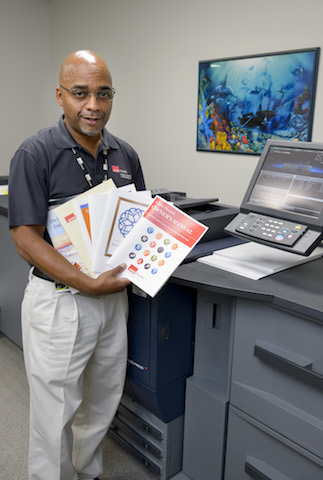
It’s loud and bustling, as various printing, copying, binding and cutting equipment churns out projects. Johnson picks up an array of printed materials to show the unique capabilities his team can provide in-house, with visually appealing designs printed on specialty papers. He hands me an invitation from the Jennie Sealy Hospital dedication, which is folded to open like a present and reveals a glossy picture of the new hospital. It’s not your average brochure or invitation—it’s a creative idea brought to life. Johnson tries to stay ahead of the curve when it comes to advances in printing technologies.
“We are now steering people away from lamination to using polyester, instead,” he says. “The quality of photos printed on polyester is top-notch and it is durable and waterproof. We used polyester for a recent project with Environmental Services, where we printed photos of made-up hospital rooms as a guide for housekeeping staff. Now, when they are cleaning a room, they can pull out the photo from their pocket and see how everything is supposed to look.”
For the most part, Johnson says advances in technology have made it possible to do printing on-demand, as opposed to the “old days,” when his team would print tons of copies to be stored until needed, or became outdated and thrown away. Not only is today’s method more efficient, it’s better for the environment.
“Now we print exactly what people need,” he says, picking up a clinic one-pager listing the physicians and location. “We only print about 50 of these at a time for the clinic. That way, if one of their doctors leaves or a new one comes on board, they can just send us a new file and we can print updated ones, without producing much waste.”
One machine that runs almost non-stop is known as the “Riso.” Short for “risograph,” it’s a high-speed digital ink-jet printing system that prints the patient billing statements for all UTMB hospitals and clinics.
“It can print 150 pages a minute—that’s the fastest available on the market,” says Johnson. “This is all self-contained to protect patient confidentiality. The printer automatically downloads statements from Epic and once they are printed, they immediately go to mail services, which is located on this same floor.”
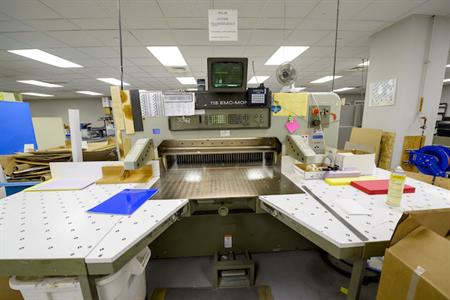
Johnson notices my deer-in-the-headlights expression when he mentions unfamiliar print shop vocabulary, so he takes his time explaining terms such as “saddle stitch” and “perfect binding,” and printing processes such as “offset” versus “digital.”
“Offset printing is a commonly used method where an inked image is transferred from a plate to a rubber blanket, then to paper,” says Johnson, who adds that it is a lithographic process based on the repulsion of oil and water. “We have a digital-offset printer that can image all four color plates simultaneously on the press. It’s phenomenal compared to the old offset presses, where we would have to manually hang plates with wrenches and tools.”
While I’m impressed by all the printing presses, one of my favorite pieces of equipment is the “Guillotine.” Appropriately named, this intimidating piece of equipment is a commercial grade trimmer that can cut through1,000 sheets of paper at one time. Fortunately, the employee operating the machine must keep both hands on separate buttons—far away from the blades—for the machine to work.
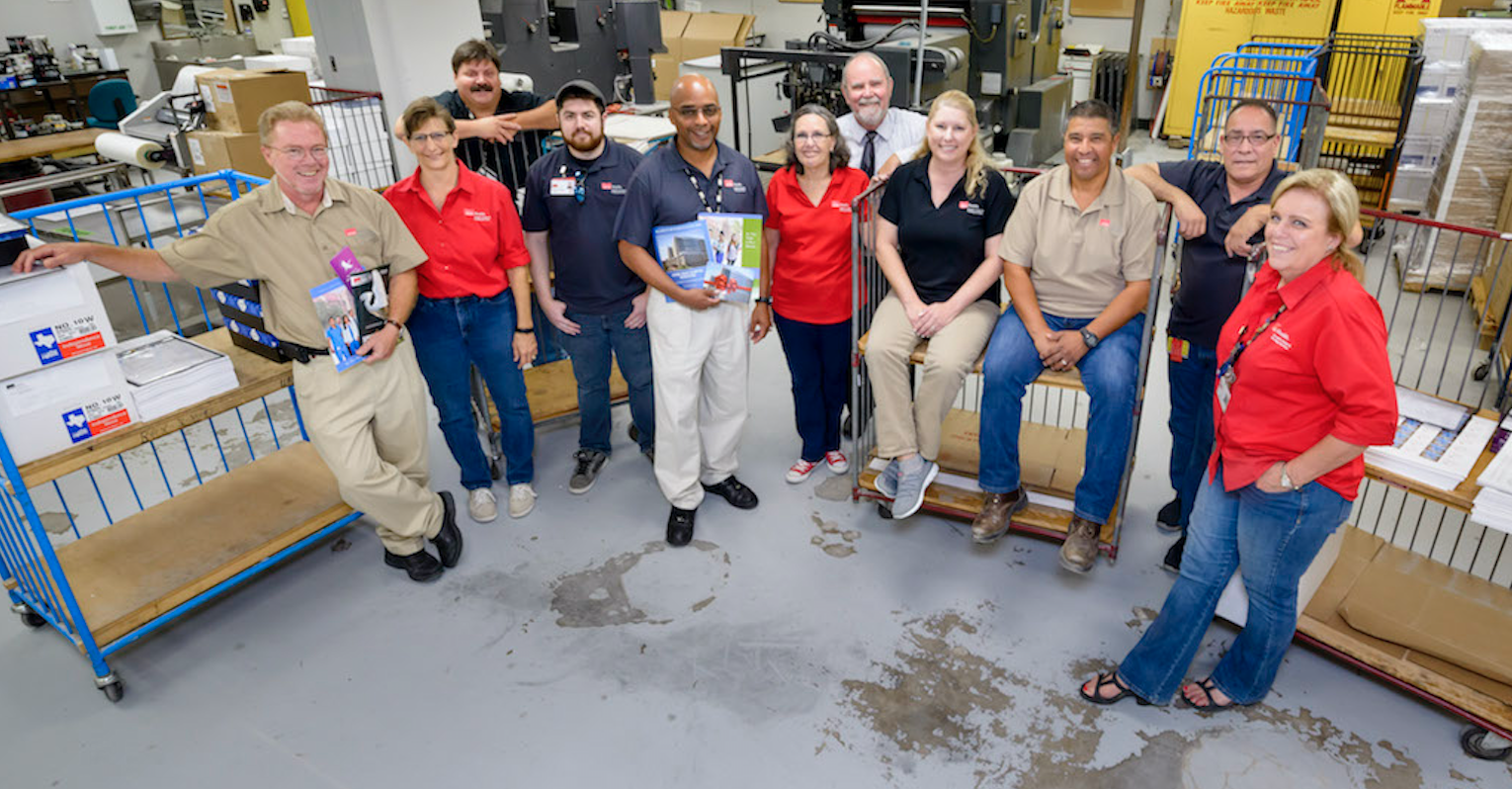
As I watched the Guillotine in action, Johnson tells me the best part about his job is his hard-working team, who he wants to make sure receives due credit. I’m introduced to several employees, including
Betty Ince, who greets us at the front desk as she takes orders from the online ordering website (Print Pro);
Mary Beth Enriquez, who deals with all customer service coordination;
Holly Rocha, the lead graphic designer who ensures all projects adhere to branding guidelines;
Bruce Gilmer, who provides customer service and custom pricing quotes;
Nancy Ponsetti, who coordinates all production;
Michael Sipula, a print/binder technician; and contractors
Greg Castro and
Matthew Garza. A trip to the print shop wouldn’t be complete without meeting Pete Rocha, a senior print/binder technician for the past 31 years, who greets me with a warm smile as he prints 20,000 UTMB-branded envelopes. It’s clear that the print shop staff is the heart of the operation.
“It takes everybody—and we are used to having super tight turnarounds,”says Johnson. “That’s the beauty of having your own print shop on campus. I remember when there was an Ebola scare on one of the cruise ships that came into Galveston last year. We got a call from the President’s Office that they needed signage, posters and pamphlets to direct passengers to a triage area that UTMB set up to test passengers. We were only a phone call away, and we came in on the weekend to get the job done.”
Johnson is a team player and is humble in all aspects of his work—aptly calling himself a “gap filler.” Wherever there is a gap or a bottleneck in production, you’ll find him trying to relieve it, whether it’s troubleshooting an equipment malfunction or hand-delivering proofs to customers.
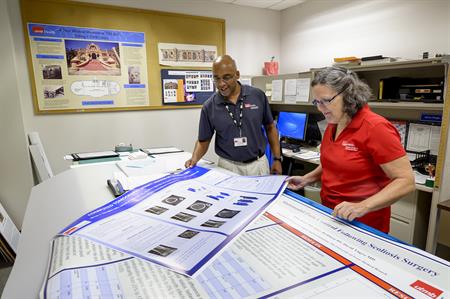
“I think we have pretty good customer relationships—we go over and above,” says Johnson. “If we can find a cheaper way to do the job, we’ll pass the cost savings on to the customer—that’s one thing that most commercial shops won’t do. And we can come to your office so you don’t have to worry about losing your parking spot in 98-degree heat (laughs).”
It’s fascinating to see what Johnson and his team do every day to fulfill UTMB’s printing and graphics needs. They continue to evolve to ensure customers get the best product at the best price—all while bringing new ideas to life.
“What comes out of this shop and what these people do is amazing—most people don’t understand,” says Johnson. “We’re a well-kept secret, but those who need us, know us.”